The next-gen MacBook Pro with Retina Display Review
by Anand Lal Shimpi on June 23, 2012 4:14 AM EST- Posted in
- Mac
- Apple
- MacBook Pro
- Laptops
- Notebooks
All Flash Storage
As expected, the next-gen MacBook Pro ditches mechanical storage in favor of a MacBook Air style NAND + SSD controller on a custom PCB. Apple refers to this solution as all-flash storage.
Apple’s distinction between Solid State Drives (SSDs) and all-flash storage boils down to what form the storage comes in. If it’s a standard form factor device in a chassis, it’s a solid state drive. If it’s just NAND + controller on a PCB? Then it’s all-flash storage. I suspect it’s a nicer way of saying proprietary SSD but either way they are technically the same thing, just in different forms.
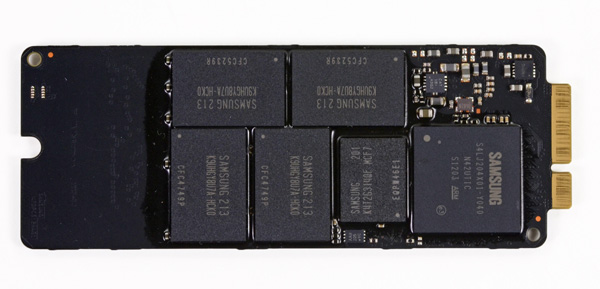
The Samsung PM830 based rMBP NAND flash storage card, image courtesy iFixit
My Retina MacBook Pro was the upgraded model with a 512GB SSD, featuring Samsung’s PM830 controller. This is the same controller as in the Samsung SSD 830, which I’ve long felt was the best pair for Mac users who wanted an SSD upgrade. I’m not sure if other Retina MBPs may come with Toshiba’s SandForce based drive instead. I have one of these drives in house for a review but that’ll have to wait until next week.
Although both the Samsung and Toshiba/SandForce controllers support full disk encryption, neither hardware based encryption is supported by OS X’s FileVault 2. When OS X encrypts your boot volume not all areas are encrypted (such as the recovery partition). While I know SandForce allegedly offers multiple encryption levels across a volume I’ve never seen either controller claim support for partially unencrypted volumes. In this case it looks like for Apple to take advantage of SSD controller based encryption it would need more flexible encryption support on the controller level. If I were an SSD controller vendor I’d be paying close attention to this requirement.
Both the Samsung and Toshiba controllers support 6Gbps SATA - as a result performance is significantly better compared to previous Apple branded SSDs. I borrowed a friend’s 2010 MacBook Pro which happened to have a Toshiba based SSD installed and ran it through our standard Iometer four-corners test suite. This was a well used drive and thus the performance is even worse than last year's MacBook Airs. The improvement in performance is astounding:
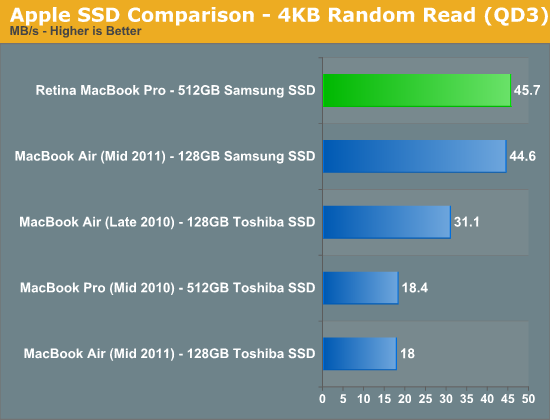
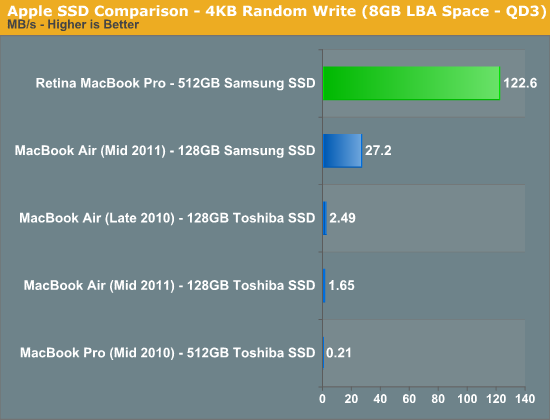
The move to 6Gbps SATA is often associated with a huge bump in sequential transfer rates, but in this case Apple enjoys a significant increase in random speeds as well. Note that some of this improvement is going to be due to the fully populated configuration of the PM830 in the Retina MacBook Pro's SSD, but that shouldn't downplay the significance of the move to Samsung's latest controller. The previous generation controller used last year just wasn't very good, and the Toshiba alternative was even worse. This year, Apple finally has a good solid state story to tell.
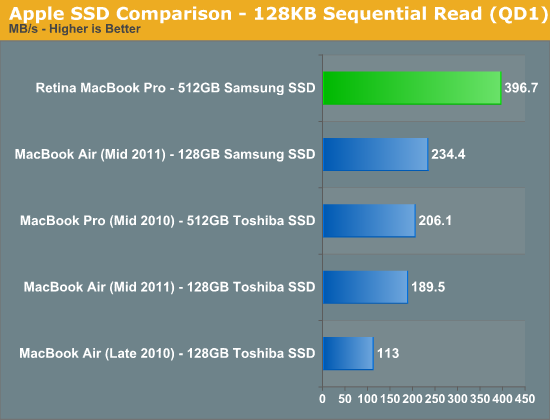
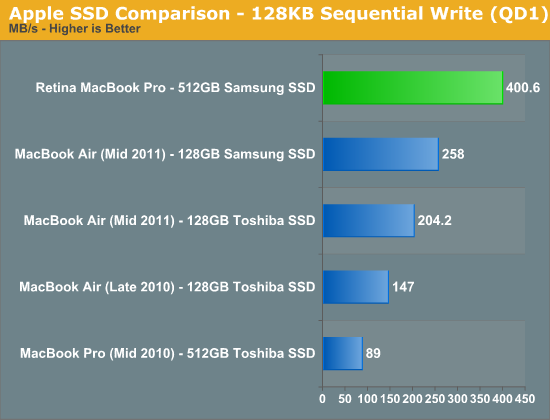
How much of this are you going to be able to actually tell in day to day use of the system? The sequential transfer rates are most tangible when you are writing to or reading large files like movies to your drive. Obviously you need a source that's fast enough to hit these speeds. Although USB 3.0 can come close you're unlikely to have a USB 3.0 SSD that's as fast as the internal drive. Moving large files between your internal SSD and Promise's Pegasus R4/R6 is where you'll really appreciate this performance.
The random access improvements are likely overkill for most normal uses. Things like program launches, compiling, web browsing, and any other normal application IO will depend on a mixture of random and sequential IO. The key is to have good enough random IO performance to avoid becoming a bottleneck. I can safely say that the numbers we see here are more than enough.
While previous Apple SSDs were nice only from a convenience standpoint, at least the Samsung option in the Retina MacBook Pro is what I’d recommend even if Apple didn’t bundle it with the machine.










471 Comments
View All Comments
RaygunV - Sunday, June 24, 2012 - link
Apple has done nothing. Higher resolutions were already in the pipeline before apple released theirs. Apple releases first only so that the public DOES think they are innovative.Apple has done nothing special, just using maturing technology like all vendors will.
http://www.tomshardware.com/news/Intel-Higher-Reso...
designerfx - Sunday, June 24, 2012 - link
the same as apple: improving on plenty of things while missing the boat.apple: lack of improvements on hardware (not their fault, but raising resolution without a substantially more powerful GPU = things tend to suck if you try to take advantage of the resolution).
Note all the benchmarks at the scaled down resolution on the GPU testing. You don't even want to know what these games will run at with 28xx by 18xx.
If 1680x1050 is achieving 60fps, it's not hard to guess that 15fps might be an optimistic answer at 2800x1800.
Meanwhile, all this "Scale the appropriate elements while letting the rest display full resolution" is an important part of the OS that windows 8 probably will miss, entirely.
Spunjji - Monday, June 25, 2012 - link
Sony, Vaio Z, 13" 1920x1080. Thanks, Apple? :|starburns - Monday, June 25, 2012 - link
http://en.wikipedia.org/wiki/Ultra_High_Definition...Super resolutions have been around since 2005, this retina display is still only half the resolution that other companies have achieved years ago.
KitsuneKnight - Saturday, July 7, 2012 - link
Displays that cost enough to buy 5+ of these laptops (if you find them on firesale!). Not really comparable.optics261 - Saturday, June 23, 2012 - link
One review to rule them all!zappb - Saturday, June 23, 2012 - link
With 4k resolution screens to bind them. Apple=progress (finally).After years of ignoring screen quality Lenovo, dell, hp....thanks pingguo.
yhselp - Saturday, June 23, 2012 - link
One Review to rule them all, One Review to show them, One Review to teach them all and in the darkness more objective make them.eron - Saturday, June 23, 2012 - link
What software was used to measure the frame rate?Spoony - Saturday, June 23, 2012 - link
Quartz Debug. Part of Apple's developer tools. There is a string you can use to expose additional functionality in Quartz Debug such as resolution scaling factor and manual GPU switching.$ defaults write com.apple.QuartzDebug QuartzDebugPrivateInterface -boolean YES